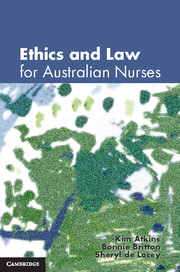Book contents
- Frontmatter
- Contents
- Introduction
- 1 Understanding the human person
- 2 Understanding legal rights and obligations
- 3 Nursing and the legal system
- 4 The nurse–patient relationship
- 5 Consent
- 6 Duty of care and professional negligence
- 7 Patient information, confidentiality and trust
- 8 ‘Trust me, I’m a nurse’
- 9 Witnessing and making mistakes
- Appendix: Tables of legislation
- References
- Index
9 - Witnessing and making mistakes
- Frontmatter
- Contents
- Introduction
- 1 Understanding the human person
- 2 Understanding legal rights and obligations
- 3 Nursing and the legal system
- 4 The nurse–patient relationship
- 5 Consent
- 6 Duty of care and professional negligence
- 7 Patient information, confidentiality and trust
- 8 ‘Trust me, I’m a nurse’
- 9 Witnessing and making mistakes
- Appendix: Tables of legislation
- References
- Index
Summary
LEARNING OBJECTIVES
In this chapter, you will:
Understand the nature of professional self-respect and its connection to trustworthiness
Understand the nature of trust and its role in the clinical relationship
Understand the factors that lead to clinical errors and incidents
Understand some factors that influence nurses’ decisions about reporting errors
Understand Open Disclosure policy
Apari had been caring for a diabetic man, Jack, whose blood glucose levels had been difficult to regulate. One day they would be high, the next day they would be low. By chance one day Apari saw that a new nurse, Louise, was using the glucometer incorrectly to test Jack's blood glucose. Apari checked Jack's notes and realised that Louise had been recording incorrect blood glucose levels for several days.
Just like everyone else, nurses sometimes make mistakes that can result in harm to others. The ANMC Code of Professional Conduct (2008b) makes a number of statements regarding safe conduct – for example:
Conduct Statement 1: Nurses practise in a safe and competent manner.
Conduct Statement 2: Nurses practise in accordance with the standards of the profession and broader health system.
Conduct Statement 3: Nurses practise and conduct themselves in accordance with laws relevant to the profession and practice of nursing.
The ANMC Code of Ethics (2008a) also refers to safe conduct:
Value Statement 1: Nurses value quality nursing care for all people.
Value Statement 6: Nurses value a culture of safety in nursing and health care.
- Type
- Chapter
- Information
- Ethics and Law for Australian Nurses , pp. 195 - 220Publisher: Cambridge University PressPrint publication year: 2011



